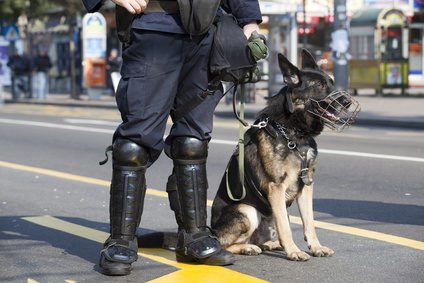
Fatalities resulting from police K-9 deployments are statistically rare. Nonetheless, the incidents that have occurred—and their underlying circumstances—warrant serious legal and operational scrutiny. Courts have long held that K-9s do not constitute “deadly force” under the Fourth Amendment. Yet, as real-world outcomes show, police dogs are capable of inflicting fatal injuries under predictable conditions.
Why K-9 Fatalities Are Rare — But Not Inconceivable
Police dogs are trained to apprehend suspects by biting and holding until commanded to release. In most cases, handlers remain in close proximity and can terminate an attack quickly. Further, dogs are generally trained to target the limbs or torso, rather than the head or neck. This reduces the likelihood of fatal vascular injuries. However, training and proximity are safeguards—not guarantees.
When those controls break down, the risk of death becomes real. Bites to the neck can puncture the carotid artery or jugular vein, leading to rapid exsanguination. A powerful bite to the leg, if it severs a major artery, can also be fatal.
Documented Fatalities Involving Police K-9s
The following cases illustrate the lethal potential of police dogs when circumstances deviate from protocol:
-
Robinette v. Barnes (1984): A suspect hiding under a car was killed by a police dog. The Sixth Circuit held that use of a properly trained K-9 to apprehend a fleeing felon did not constitute deadly force under Tennessee v. Garner. The court emphasized that K-9 force was distinguishable from firearms in both intent and effect.
-
Laurene MacLeod (1990): In West Palm Beach, Florida, a homeless woman was mauled by a 108-lb German Shepherd while sleeping in an abandoned house. She was handcuffed and lying prone when attacked. She died in the hospital 15 hours later.
-
Unnamed Victim (2012): An elderly man was attacked while sleeping under a bush during a K-9 search for a burglary suspect. He died weeks later from complications. A wrongful death claim resulted in a $1.5 million settlement.
-
Joseph Pettaway (2018): In Montgomery, Alabama, Pettaway was repairing a home when mistaken for an intruder. A police dog ruptured an artery in his leg, and he died shortly after. Litigation is ongoing.
Legal Framework: The Deadly Force Debate
U.S. appellate courts have generally found that deployment of a police K-9 does not constitute “deadly force” per se. Robinette v. Barnes, for example, draws a categorical distinction between police dogs and firearms. The court reasoned that the intent behind a dog’s use is apprehension—not termination—and that handlers can control the level of force through training and commands.
However, this reasoning deserves re-evaluation. Unlike batons, tasers, or pepper spray—where the officer controls duration, force, and targeting—a K-9 possesses autonomous decision-making in real time. Once deployed, the dog determines when to bite, where to bite, and how long to maintain the bite. The handler’s control is partial, not absolute.
This introduces a materially different risk profile. If a K-9 can inflict death in foreseeable circumstances, and if handlers cannot reliably control that outcome, then courts and policymakers should reconsider whether K-9s should be legally treated as instruments of non-lethal force.
Conclusion
The jurisprudential position that police K-9s are not “deadly force” is increasingly misaligned with operational realities. A growing body of case law and fatal incidents demonstrates that:
-
Police dogs are capable of causing death through vascular trauma or prolonged attack;
-
Handler control is imperfect, especially under field conditions;
-
The outcomes in certain deployments are indistinguishable from the application of deadly force.
Accordingly, there is a strong argument that police K-9s, when used for suspect apprehension, should be classified as potentially lethal force—requiring a higher threshold of justification under Graham v. Connor and Tennessee v. Garner.
At minimum, courts should adopt a more nuanced framework that assesses K-9 deployments on a case-by-case basis, accounting for the dog’s training, handler proximity, targeting behavior, and the specific facts of the encounter. A categorical presumption that police dogs are “non-lethal” no longer withstands empirical or legal scrutiny.
